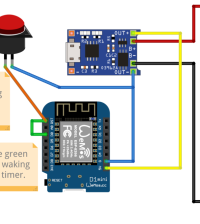- How to Adjust X and Y Axis Scale in Arduino Serial Plotter (No Extra Software Needed)Posted 2 months ago
- Elettronici Entusiasti: Inspiring Makers at Maker Faire Rome 2024Posted 2 months ago
- makeITcircular 2024 content launched – Part of Maker Faire Rome 2024Posted 5 months ago
- Application For Maker Faire Rome 2024: Deadline June 20thPosted 6 months ago
- Building a 3D Digital Clock with ArduinoPosted 11 months ago
- Creating a controller for Minecraft with realistic body movements using ArduinoPosted 12 months ago
- Snowflake with ArduinoPosted 12 months ago
- Holographic Christmas TreePosted 12 months ago
- Segstick: Build Your Own Self-Balancing Vehicle in Just 2 Days with ArduinoPosted 1 year ago
- ZSWatch: An Open-Source Smartwatch Project Based on the Zephyr Operating SystemPosted 1 year ago
Minim Labs Toolkit Secures and Manages All IoT Home Devices

At the Consumer Electronics Show Minim announced a free spin-off of Minim, its cloud-managed WiFi and security Software as a Service (SaaS) platform. Minim Labs is designed to work with a new open source software agent called Unum that runs on Raspbian and OpenWrt Linux devices.
The Minim Labs toolkit secures and manages all connected devices in the home, such as the Google Home Hub, Sony Smart TV, and FreeRTOS devices, providing device fingerprinting, security scans, AI-powered recommendations, router management, analytics, and parental controls. By signing up to a Minim Labs account you receive a MAC address to register an Unum-enabled device.
The GitHub hosted Unum agent runs on the Linux router where it identifies connected devices and securely streams device telemetry to the Minim platform. Users can open a free Minim Labs account to register up to 10 Unum-enabled devices, offering access to Minim WiFi management apps and APIs.
“By open sourcing our agent and giving technologists free access to our platform, we hope to build a global community that’ll contribute valuable product feedback and code,” stated Jeremy Hitchcock, Founder and CEO of Minim.
Further information can be found into the original post on LinuxGizmos.com.
















